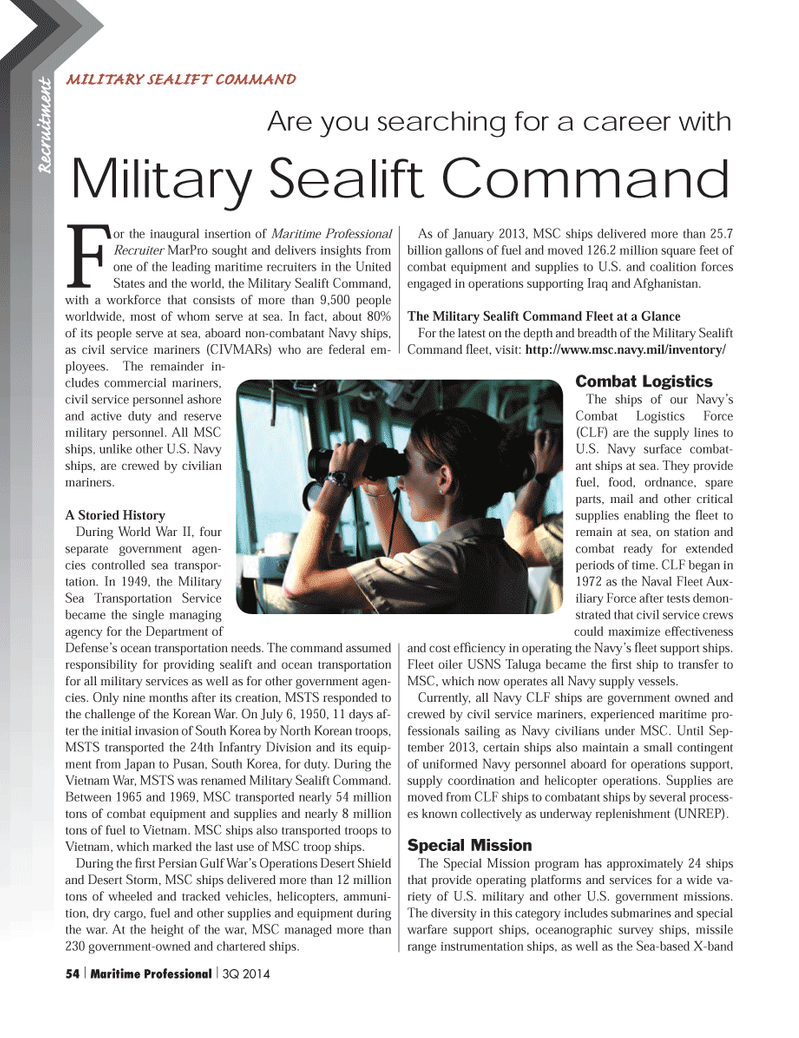
Page 54: of Maritime Logistics Professional Magazine (Q3 2014)
Power & Fuel Management
Read this page in Pdf, Flash or Html5 edition of Q3 2014 Maritime Logistics Professional Magazine
Recruitment Recruitment For the inaugural insertion of Maritime Professional Recruiter MarPro sought and delivers insights from one of the leading maritime recruiters in the United States and the world, the Military Sealift Command, with a workforce that consists of more than 9,500 people worldwide, most of whom serve at sea. In fact, about 80% of its people serve at sea, aboard non-combatant Navy ships, as civil service mariners (CIVMARs) who are federal em- ployees. The remainder in- cludes commercial mariners, civil service personnel ashore and active duty and reserve military personnel. All MSC ships, unlike other U.S. Navy ships, are crewed by civilian mariners. A Storied History During World War II, four separate government agen- cies controlled sea transpor- tation. In 1949, the Military Sea Transportation Service became the single managing agency for the Department of Defense?s ocean transportation needs. The command assumed responsibility for providing sealift and ocean transportation for all military services as well as for other government agen- cies. Only nine months after its creation, MSTS responded to the challenge of the Korean War. On July 6, 1950, 11 days af- ter the initial invasion of South Korea by North Korean troops, MSTS transported the 24th Infantry Division and its equip- ment from Japan to Pusan, South Korea, for duty. During the Vietnam War, MSTS was renamed Military Sealift Command. Between 1965 and 1969, MSC transported nearly 54 million tons of combat equipment and supplies and nearly 8 million tons of fuel to Vietnam. MSC ships also transported troops to Vietnam, which marked the last use of MSC troop ships. During the rst Persian Gulf War?s Operations Desert Shield and Desert Storm, MSC ships delivered more than 12 million tons of wheeled and tracked vehicles, helicopters, ammuni- tion, dry cargo, fuel and other supplies and equipment during the war. At the height of the war, MSC managed more than 230 government-owned and chartered ships. As of January 2013, MSC ships delivered more than 25.7 billion gallons of fuel and moved 126.2 million square feet of combat equipment and supplies to U.S. and coalition forces engaged in operations supporting Iraq and Afghanistan. The Military Sealift Command Fleet at a GlanceFor the latest on the depth and breadth of the Military Sealift Command eet, visit: http://www.msc.navy.mil/inventory/ Combat Logistics The ships of our Navy?s Combat Logistics Force (CLF) are the supply lines to U.S. Navy surface combat- ant ships at sea. They provide fuel, food, ordnance, spare parts, mail and other critical supplies enabling the eet to remain at sea, on station and combat ready for extended periods of time. CLF began in 1972 as the Naval Fleet Aux- iliary Force after tests demon- strated that civil service crews could maximize effectiveness and cost ef ciency in operating the Navy?s eet support ships. Fleet oiler USNS Taluga became the rst ship to transfer to MSC, which now operates all Navy supply vessels. Currently, all Navy CLF ships are government owned and crewed by civil service mariners, experienced maritime pro- fessionals sailing as Navy civilians under MSC. Until Sep- tember 2013, certain ships also maintain a small contingent of uniformed Navy personnel aboard for operations support, supply coordination and helicopter operations. Supplies are moved from CLF ships to combatant ships by several process- es known collectively as underway replenishment (UNREP). Special MissionThe Special Mission program has approximately 24 ships that provide operating platforms and services for a wide va- riety of U.S. military and other U.S. government missions. The diversity in this category includes submarines and special warfare support ships, oceanographic survey ships, missile range instrumentation ships, as well as the Sea-based X-band MILITARY SEALIFT COMMAND Are you searching for a career withMilitary Sealift Command54 | Maritime Professional | 3Q 201450-63 Q3 MP2014.indd 5450-63 Q3 MP2014.indd 548/13/2014 2:48:10 PM8/13/2014 2:48:10 PM

 53
53

 55
55
